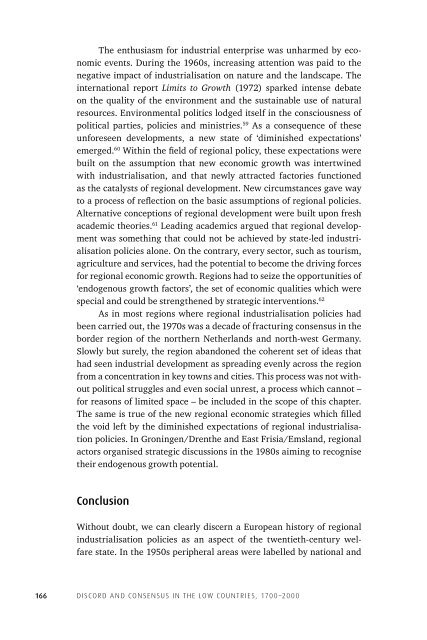Discord Consensus
7aze300jFJo
7aze300jFJo
Create successful ePaper yourself
Turn your PDF publications into a flip-book with our unique Google optimized e-Paper software.
The enthusiasm for industrial enterprise was unharmed by economic<br />
events. During the 1960s, increasing attention was paid to the<br />
negative impact of industrialisation on nature and the landscape. The<br />
international report Limits to Growth (1972) sparked intense debate<br />
on the quality of the environment and the sustainable use of natural<br />
resources. Environmental politics lodged itself in the consciousness of<br />
political parties, policies and ministries. 59 As a consequence of these<br />
unforeseen developments, a new state of ‘diminished expectations’<br />
emerged. 60 Within the field of regional policy, these expectations were<br />
built on the assumption that new economic growth was intertwined<br />
with industrialisation, and that newly attracted factories functioned<br />
as the catalysts of regional development. New circumstances gave way<br />
to a process of reflection on the basic assumptions of regional policies.<br />
Alternative conceptions of regional development were built upon fresh<br />
academic theories. 61 Leading academics argued that regional development<br />
was something that could not be achieved by state-led industrialisation<br />
policies alone. On the contrary, every sector, such as tourism,<br />
agriculture and services, had the potential to become the driving forces<br />
for regional economic growth. Regions had to seize the opportunities of<br />
‘endogenous growth factors’, the set of economic qualities which were<br />
special and could be strengthened by strategic interventions. 62<br />
As in most regions where regional industrialisation policies had<br />
been carried out, the 1970s was a decade of fracturing consensus in the<br />
border region of the northern Netherlands and north-west Germany.<br />
Slowly but surely, the region abandoned the coherent set of ideas that<br />
had seen industrial development as spreading evenly across the region<br />
from a concentration in key towns and cities. This process was not without<br />
political struggles and even social unrest, a process which cannot –<br />
for reasons of limited space –be included in the scope of this chapter.<br />
The same is true of the new regional economic strategies which filled<br />
the void left by the diminished expectations of regional industrialisation<br />
policies. In Groningen/Drenthe and East Frisia/Emsland, regional<br />
actors organised strategic discussions in the 1980s aiming to recognise<br />
their endogenous growth potential.<br />
Conclusion<br />
Without doubt, we can clearly discern a European history of regional<br />
industrialisation policies as an aspect of the twentieth-century welfare<br />
state. In the 1950s peripheral areas were labelled by national and<br />
166<br />
DISCORD AND CONSENSUS IN THE LOW COUNTRIES, 1700–2000


